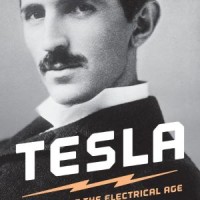Kevin Reads Stuff So You Don't Have To: "Tesla: Inventor of the Electrical Age"
- Details
- Published on Sunday, 20 October 2013 17:55
- Written by Kevin Kizer
“You may think me a dreamer...but I can tell you that I look forward with absolute confidence to sending messages through the earth without any wires.”
- Nikola Tesla, 1894
When it comes to the great inventors of the electrical age, for some reason, Nikola Tesla generally is overlooked at least in American textbooks.
Sure, we read all about Edison, Bell and even Marconi. But strangely enough the man who created modern AC technology and made great strides in broadcast communications receives barely a passing glance – and after reading this biography there seems to be two reasons why: an unwillingness to see his inventions through to production and a predisposition towards boasting about his not-yet inventions. But first, the backstory.
Born in 1856 in Croatia of Serbian descent, Tesla was brought into a family where most of the men took up a very popular profession at the time: Orthodox priest. While Nikola showed phenomenal intelligence, his father and uncles wanted him to go into the family business, as it were. But Tesla’s success at school – including being able to perform calculus in his head – was proof that he had a future elsewhere.
Tesla had a phenomenal but spotty education, bouncing from school to school, before ending up in Budapest where he got a job at the Budapest Telephone Company in 1881. He took to his work like his studies and, in just one year, made great technological strides, including many improvements on the company’s equipment.
One year later, Tesla got a job in France with Thomas Edison’s European company, Continental Edison Company. And two years after that, Tesla found himself in New York working for Edison himself.
After he made massive breakthroughs in efficiency and power through his redesign of Edison’s motors and generators, Tesla decided it was time to strike out on his own. The year was 1887 and the 31-year-old Croatian immigrant launched the Tesla Electric Company with absolutely no fanfare and a little funding.
At the time, motors operated on direct current (DC), which had limitations when it came to transmission over distances. However, alternating current (AC) had few limitations when it came to transmitting over the long distances. But there was a problem: motors and generators could not run on an AC current.
Inventors were desperate to come up with workable AC motors and they went through page after page of unworkable designs. Amazingly enough Tesla was able to crack the AC challenge in his head, just like calculus when he was younger. Unlike most inventors who started designing or engineering their ideas on paper (or blackboards), Tesla had an uncanny ability to design and engineer his inventions in his head before he put anything down on paper (or board). He literally could visualize his machines working not just on a whole but part by part.
In 1888, he had a patent for a workable AC motor and the world of electricity was on the verge of a technological revolution. While it brought fame for Tesla, it also brought on lawsuits and patent cases, which would plague him throughout the rest of his life.
Tesla also had the flair of a showman, making spectacular demonstration of his electrical inventions. One of his favorite displays involved illuminating various glass tubes and spheres with different gases to create a kind of primitive neon effect. Some of his machines would send giant electric bolts across 15-20 feet of space. At times, his visitors would be physically overwhelmed by the spectacle. Others – like Mark Twain – were thoroughly fascinated (the two became very good friends). At one point, to demonstrate the safety of AC power, Tesla took a 250,000-volt shock through his body.
As Carlson writes, Tesla’s life “had a spectacular ascent (1884-94)” which was followed by “an equally dramatic descent (1895-1905).” During those ascending years, Tesla developed what is known as the Tesla coil, a high-frequency, high-voltage transformer; several radio-controlled devices (including remote-control boats!); and new electric lamps, along with a myriad of other inventions.
He experimented with wireless communications as well, positing that power and communications could be sent through the earth. But most importantly, he was able to attract backers to fund his endeavors, including most notably J.P. Morgan.
However, unlike Edison and Bell, Tesla never followed through with the implementation of his inventions – he was an inventor, not a businessman. He felt it was the job of others to make practical use of his work.
Unlike Edison and Bell, Tesla regularly boasted of his inventions before they were a reality – perhaps because he could picture them working in his head. In 1899, he boldly stated he would transmit messages across the Atlantic. But Marconi beat him to it in 1901. So Marconi is the one we read about in the history books.
And it was around this time that the man who in 1894 had been proclaimed by Electrical Engineer as to have “achieved such a universal scientific reputation” began his downfall. By 1903, the press was writing that the name Tesla “provokes at best a regret that so great a promise should have been unfulfilled.”
While Tesla lived another 40 years, he could not repeat the advances and breakthroughs he made in the 1890s – nor could he find the businessmen to back him financially. He spent a great many of those last 40 years nearly penniless, while still attempting to make new technological innovations and realize his dream of wireless communications.
Despite his failures, he always drew the interest of the press, who loved to print his fantastical boasts about his future inventions: a new motor that would work on cosmic rays, a pocket-sized mechanical oscillator that could destroy the Empire State building, a particle-beam weapon that could bring down an aircraft, and even machines that allowed him to receive transmissions from Mars and extraterrestrial life.
In the end, Nikola Tesla was the poster child for the eccentric genius. He was the man who ushered in the era of modern electricity and whose ideas and vision helped inspire future inventors (his dream of using short wave impulses to detect ships were inspiration for radar pioneer, Emile Girardeau), while at the same time he was the man who sent a telegraph messenger to deliver $100 to his friend Mark Twain – nearly 30 years after Twain’s death.
Almost every biographer focuses on the eccentric side of Tesla because, well, there’s a lot of material there, e.g. he was kicked out of one New York hotel for having too many pigeons in his room and one corner of Bryant Park behind the New York Public Library – the place where he would feed the pigeons almost daily – is officially designated “Nikola Tesla Corner.”
But in this book Carlson balances the eccentricities with the genius, showing the cultural and technological impact of Tesla’s work, as well as delving into the individual machines he built – the successes as well as the failures. Hopefully, at the very least, this new biography will underscore Nikola Tesla’s rightfully earned place among the forefathers of modern technology.
"Tesla: Inventor of the Electrical Age"
By W. Bernard Carlson
399 pages
Princeton University Press


















































